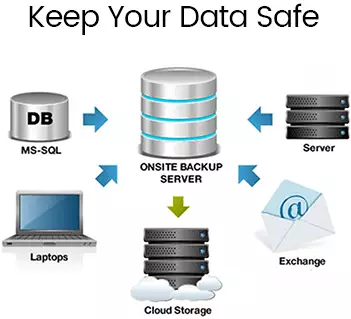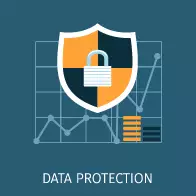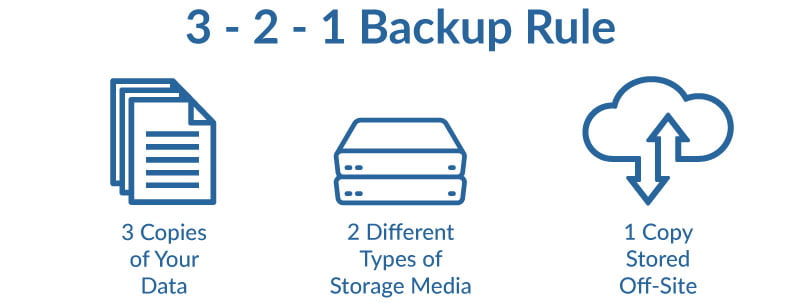Backup & Disaster Recovery
What would be the cost to your business if you lost critical data?
Backup and disaster recovery (BDR) is the process of putting secure systems in place to back up your valuable data so that it can be accessed and recovered. It can only be recovered from an earlier time if you have backed it up. The threat of a security breach, system failure, or server crash to your company’s productivity and critical data can be avoided with our disaster recovery and backup services.
Effective disaster recovery planning is essential. However, research has found that only 54% of businesses surveyed had a formal disaster recovery plan in place. Having a data recovery solution, like our BDR is an essential component of a solid business continuity plan.
Your business data is the lifeblood of your company and the amount you are collecting and storing is growing all the time. Imagine the impact if you lost a day’s data, a year’s data, or complete data loss due to inadequate or infrequent back-up processes or ransomware.
- Are you prepared for a business disaster or unexpected server crash?
- Do you really know how long it takes to recover from an unexpected disaster?
- Have you figured out how much it will cost for you to be down for extended period of time?
- Can your business survive a complete loss of data event?
It’s important to implement a data recovery solution and plan as part of a business continuity plan.
Approximately 25% of businesses never reopen their doors after a disaster.

Simple, yet effective and affordable.
Our Backup and Disaster Recovery system utilizes image based backups to store the state of the system at a certain time, ensuring the safety of all data and fast restoration times. Files and folders, system configuration, apps and software are stored in an image, which can be used to restore the system in case of failure. The image can also be used for file-level restoration in the event a user loses a single document or folder.
Backups are encrypted and sent off-site to cloud storage, so you don’t need to reserve space on your local drives. By storing the data away from your primary location, it helps ensure the redundancy that you are looking for in a comprehensive backup system.
To ensure that your company is protected from disaster, we believe that it’s best practice to find a solution that not only backs up your data off-site, but has the ability to restore in minutes. If you currently don’t have a backup solution, then you need one. Based on an affordable, monthly flat-rate, Pennyrile Technologies’ Backup and Disaster Recovery solution is a smart way to protect your business.

Supreme Flexibility
Recover your documents, email, or systems from nearly any point in time, whether it is just a single file or a full restore.

Fully Managed System
We regularly monitor and test the backups to ensure they are working, and will act immediately if there is an issue.

Virtual Server Support
Backup your virtual servers with the same reliability that you use to backup your physical servers.

Fast Restoration Times
Don’t wait days to retrieve data. Fast data and server restores to bare metal and dissimilar hardware, especially when compared to alternatives such as tape-based backups.

Security
Backups are encrypted before leaving the device and remains so until recovered. This prevents unscrupulous thieves from accessing the data.

Off-Site Backups
Off-site backups ensure your data is kept in a safe, secure online repository that will allow for easy access in the case of a disaster that renders your physical network unusable.
Threats Facing SMBs Today
- Loss of Data
- Unreliable Systems
- Failed Restores
- Compliance
- Costly Upkeep
- Cost of Downtime

75% of small and midsize businesses rank data loss as the most significant risk to their business.
Implementing the 3-2-1 backup strategy.
The 3-2-1 backup strategy is an approach for ensuring data resilience and protection against data loss and is recommended by Pennyrile Technologies. The strategy provides a simple and effective framework for creating backup copies of important data. The numbers in the 3-2-1 plan represent the recommended backup configuration:
3 Copies of Your Data:
- Create three copies of your critical data. This includes the original data and two additional copies. Having multiple copies helps ensure redundancy and increases the likelihood of data recovery in the event of a failure or loss.
2 Different Storage Media:
- Store the backup copies on two different types of storage media. This could involve using a combination of internal hard drives, external hard drives, network-attached storage (NAS), tapes, or cloud storage. The idea is to diversify the storage media to reduce the risk of a single type of failure affecting all copies.
1 Copy Offsite:
- Keep at least one copy of your data offsite or in a geographically separate location. Storing a copy offsite protects against disasters such as fires, floods, or other events that could impact the primary location. This offsite copy can be stored in a cloud backup service, a remote data center, or another physical location.
Backup and disaster recovery (BDR) is the process of copying and storing files in a specific location, and then recovering or restoring those files when an emergency occurs, such as data loss or data corruption. Backup and disaster recovery are two separate but connected concepts that organizations should always consider together.
A Backup and Disaster Recovery (BDR) plan is a comprehensive strategy that organizations implement to ensure the protection of data, applications, and IT systems in the event of data loss, system failures, natural disasters, or other unforeseen incidents. The primary goals of a BDR plan are to minimize downtime, recover data and systems quickly, and facilitate business continuity. The plan encompasses the processes, technologies, and procedures necessary to back up critical information and restore operations efficiently after a disruptive event.
The Recovery Time Objective (RTO) is a critical metric in business continuity and disaster recovery planning. RTO represents the maximum acceptable duration of time within which a business process or system must be restored after a disruption to avoid unacceptable consequences. In simpler terms, RTO defines the time frame within which an organization aims to recover its operations following an incident.
The Recovery Point Objective (RPO) is a critical metric in the context of business continuity and disaster recovery planning. RPO represents the maximum allowable data loss that an organization is willing to tolerate in the event of a disruption or disaster. In simpler terms, RPO defines the point in time to which data must be recovered following a data loss incident.
Cloud backup, also known as online backup or cloud data backup, is a method of storing and protecting digital data by sending a copy of the data over the internet to a remote server or cloud-based storage infrastructure.
Backup and disaster recovery services are critical components of a comprehensive risk management strategy. They offer protection against various threats, ensure data resilience, and enable organizations to recover quickly from disruptions, contributing to overall business resilience and continuity.
Data backups are also a requirement for many US and international data protection laws. For IT professionals working in healthcare environments, HIPAA-compliant backup and disaster recovery solutions and services are required to ensure the security, confidentiality, and availability of medical data.
The frequency of your data backups depends on many factors, including type of data, importance of data, the risk of data loss, and budget. We recommend speaking with one of our engineers to tailor a plan best suited for your business.


